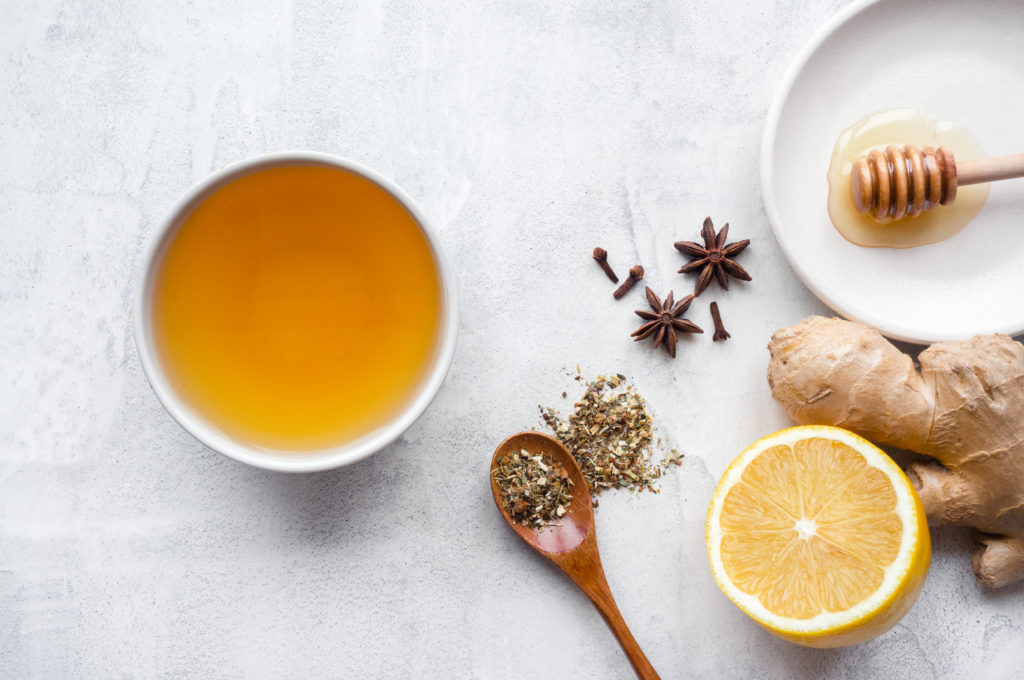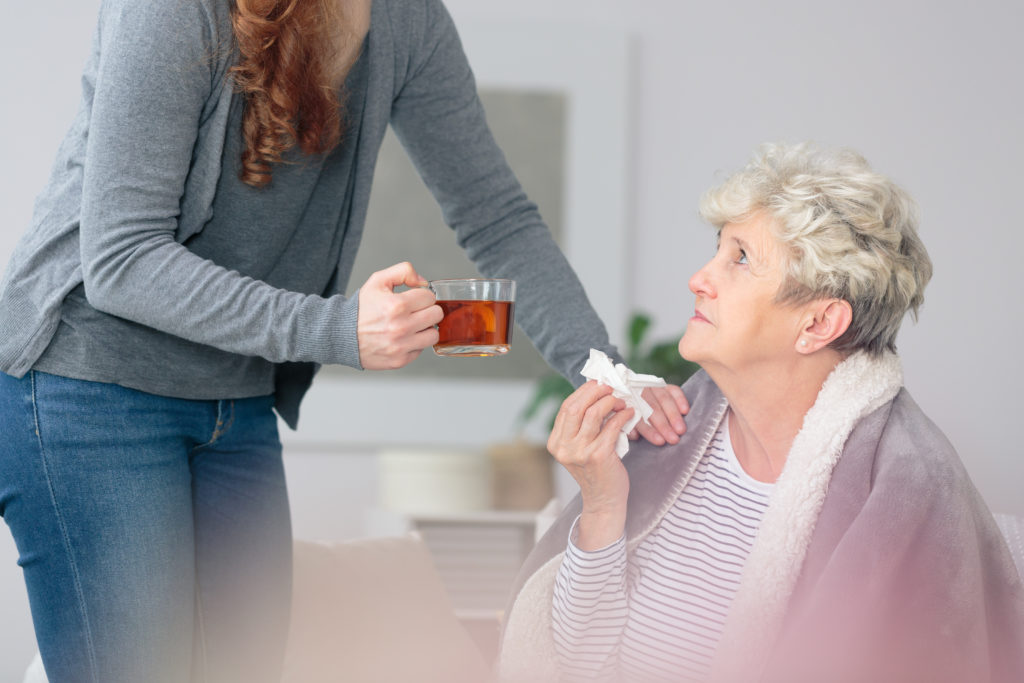After the last few weeks of working alongside my garden helper, cutting down all my ornamental grasses, and harvesting the rest of my herbal treasures (heirloom hyssop, boneset, oregano, peppermint, thyme, rosemary, and others), it occurred to me how diligently we get our yardwork done in preparation for yet another winter, yet we often don’t prepare ourselves for combating serious winter woes, and this frequently can force us to make a very dangerous choice: antibiotics!
Thinking back to last winter, I remembered the excessive amount of antibiotics being used by my own family. After mentioning to one of my nephews that antibiotics are a really bad choice, he asked me a simple question: “Yeah, but what choice do we have?” I immediately set about telling him the reasons why antibiotics are a bad choice and how he could find some safer alternatives.
Since we are now at the start of another predictably cold winter, many of us will no doubt take the seemingly easier way out and use antibiotics to combat our bacterial infections. (Please note: colds, sore throats, and the flu are all viral infections. Antibiotics can only treat bacterial infections, not viruses.) It was that thought that made me think this would be a good time to show you how to “kick ass” with my Standard Products recommendations along with some great herbal and food remedies.
Why Antibiotics Are a Dangerous Choice
By now, most of us are (or should be) fully aware that emerging bacterial strains have become resistant to antibiotics, However, the core message behind “resistant to antibiotics” seems to escape the better part of our population as most of us, first and foremost, are focused on a speedy recovery. There also seems to be a lack of understanding about what the words actually mean! Let’s learn a little about why using antibiotics can be a dangerous choice and why, unfortunately, they’re no longer effective for treating some types of bacterial infections.
In doing my research on the subject of herbal remedies, I thought to share the recommendations of a world-renowned herbalist, Stephen Harrod Buhner. I have the first edition of his book Herbal Antibiotics, but I see from his website that the second edition is now available. I encourage you put this book in your library as it’s truly a winner!
In addition to Buhner’s recommendations, I will also share some great folk remedies, interesting and relevant blog posts, and, most importantly, wonderful whole food supplements that I hope will give you and your family a sick-free and antibiotic-free winter.
What Does “Resistant to Antibiotics” Mean?
The CDC describes “resistance to antibiotics” (also known as antibiotic resistance) as follows:
“Antibiotic resistance happens when germs like bacteria and fungi develop the ability to defeat the drugs designed to kill them. That means the germs are not killed and continue to grow.
“Infections caused by antibiotic-resistant germs are difficult, and sometimes impossible, to treat. In most cases, antibiotic-resistant infections require extended hospital stays, additional follow-up doctor visits, and costly and toxic alternatives.
“Antibiotic resistance does not mean the body is becoming resistant to antibiotics; it is that bacteria have become resistant to the antibiotics designed to kill them.”
Personal note: Allow me to put my concerns about antibiotics into simple words that the average person can really understand. As I explained to my nephew, “resistant” means that the bacteria in your body has developed a way to overcome the effectiveness of the antibiotic, and therefore the antibiotic can no longer kill the bacteria that is making you so sick!
The result is that the bacterial infection just keeps getting worse, and you may develop pneumonia or some other more seriou s illness. Buhner says in his book that scientists are still trying to figure out why, after repeated use of antibiotics, certain bacterial strains begin to resist these life-saving manmade pharmaceuticals.
s illness. Buhner says in his book that scientists are still trying to figure out why, after repeated use of antibiotics, certain bacterial strains begin to resist these life-saving manmade pharmaceuticals.
This is extremely dangerous since there may be a time in your life when you really need an antibiotic and would even die without it! If we, as a population, overuse antibiotics, bacterial strains will build up a resistance to them. Eventually, antibiotics will not be able to kill a serious bacterium, and this may indeed lead to death. Buhner writes that Jim Henson, the creator of Kermit the frog, died in 1990 of this very issue (bacterial pneumonia).
Interesting to note is this quote from Herbal Antibiotics, page 4: “Although it is not commonly known, our ancestors had used both penicillin and tetracycline in raw form, as bread mold or as soil fungi, directly on wounds or even ingested to treat disease.”
These natural forms of antibiotics don’t build resistance, unlike the manmade pharmaceuticals we are now given. Yes, Mother Nature cures without killing.
Bottom line, dear reader: Consider treating simple bacterial issues with natural and holistic means. For starters, look at the many ways you can strengthen your immune system in my blog post “Healing the Immune System.”
You should have a very serious reason for taking manmade antibiotics. Start today to take reasonable measures to avoid them in the future. (I write about some of the measures you can take in my excellent blog post “Goodbye Hot, Hello Cold: Real Cause of Winter Colds.”) Otherwise, antibiotics will be rendered useless at a time when we may need them most.
The First Step to Prevention
The first step, you might have guessed, is nutrition. The specific nutrients that arm the immune system more than anything else are calcium, vitamin F complex, vitamin C complex (Ascorbic Acid on most commercial vitamin C supplements are passed off as vitamin C. Ascorbic Acid is not the whole Vitamin C complex and should not be mistaken as the whole C complex), and organ meat/glandular extracts. Good spring water, raw milk and cultured raw milk products, and many organically grown foods raised in rich, healthy soil all provide calcium in the diet. But when times call for therapeutic amounts and forms of this critical mineral and the synergistic nutrients necessary for healthy immunity, always keep your medicine cabinet stocked with the following items from Standard Process:
Calcium Lactate: Calcium engages phagocytosis, the process by which a cell engulfs material either to destroy it, to feed on it, or to get information from it. Learn how important this process is to your own immune system with Mark Anderson’s The Triad: Dr. Royal Lee and the Immune System.
Cataplex F: Vitamin F draws calcium from the bloodstream into the tissues, providing a critical chemical action that directs calcium to the infection site where it is needed most.
Cataplex C: Destroys pathogens (bacterial and viral).
Immuplex: An all-in-one whole food supplement that nourishes all four pillars of the immune system. Contains thymus, spleen, liver, and bone meal.
Herbal Antibiotics Recommended by Stephen Buhner
The exact use and preparation of these herbals are detailed nicely in Herbal Antibiotics (but I cannot include them in this article due to copyright issues). Nevertheless, so that you can take a peek at the usefulness of these herbs, I’ve supplied quotes and links below from Herbs2020, one of my favorite herbal websites.
When you read Buhner’s book, you will find many more of his recommended herbal antibiotics. Your holistic health practitioner may also suggest other herbs and/or supply you with some of the whole food supplements listed below or in one of the blog post links supplied in this article.
Nine Herbal Antibiotics Recommended in Herbal Antibiotics
- Acacia: “Acacia catechu is also used in the form of a tonic in India to treat several digestive problems, skin complaints, mouth ulcers, toothaches as well as inflamed throats. This herb contains lots of tannins and, hence, it is ideal for curing inflammations.” (Herbs2020/Acacia)
- Aloe: “As a home-based remedy for various types of burns, all kinds of physical scrapes, for the treatment of scalds, and to treat sunburn, the aloe vera is one of the best all-round first aid remedies to keep at home. The affected part of the body can be healed by the release of the soothing internal gel of a broken aloe leaf.” (Herbs2020/Aloe)
- Ginger: “The value of the ginger as an herbal medication lies in its pungent and warming properties, which are essential to treat a lot of conditions. The herbal remedies made from the ginger have a very stimulating effect on the functioning of the heart and the circulation of blood in the body, the ginger helps in creating a feeling of warmth and well-being. The herb restores vitality and physical fitness; ginger is particularly effective in those individuals who tend to deal badly with the cold during winter.” (Herbs2020/Ginger)
- Echinacea: “All of the positive effects induced by echinacea in the human body are not yet completely understood. However, what is known is that the immune system is stimulated by a number of chemical constituents found in the echinacea, and these serve to effectively counter both bacterial as well as viral infections, which can easily affect the body at any time.” (Herbs2020/Echinacea)
- Eucalyptus (Essential Oil): “Eucalyptus essential oil is also a potent inhalant and hence, it forms an active ingredient in several cold and sinus formulations…This essential oil is so potent that if you simply smell the aroma from an open bottle containing the oil, it will instantly clear any nasal congestion and make breathing easy.” (Herbs2020/Eucalyptus)
- Garlic: Garlic is one of my personal favorites. Herbs 2020 states: “All kinds of infections affecting the chest can be treated using the garlic as the primary herbal remedy. The remedy made from the garlic is good for the treatment of common colds and flu, as well as in treating ear infections, and as an herbal aid in reducing the amount of mucus produced in the nasal passages. The remedy is also effective in treating infections of the digestive system. This herbal remedy is also the treatment of choice to rid the body of all kinds of intestinal parasites and pathogens.” (Herbs2020/Garlic)
- Goldenseal: “A goldenseal root-based compound called berberine, an alkaloid, is very effective in the treatment of inflammations…” However, please keep in mind this warning from Herbs2020: “Goldenseal remedy must not be used for extended periods of time as the remedy can drastically lower the nutrient absorption capacity of the gut—particularly the absorption of B vitamins in the stomach.” (Herbs2020/Goldenseal)
- Manuka honey: Honey is still used as a folk medication owing to its comforting properties, which is especially true in the treatment if colds and coughs. I highly recommend manuka honey in particular. As noted by Herbs2020, “Manuka honey is strikingly thixotropic (gels that lose viscosity and turn into liquid when stirred) and has been found to have the maximum viscosity among an assortment of honeys that have been examined by researchers. This particular characteristic of manuka honey is attributed to the presence of a specific colloid or protein, in addition to its key visually identifiable nature. A honey can be branded as manuka honey only if a minimum of 70 percent of pollens contained by it has their origin in Leptospermum scoparium.” (Herbs2020/Manuka Honey)
—Note: honey is contraindicated for infants and children. - Sage: “Sage can be used for all types of sore throats. This is because of the fact that sage has antiseptic and astringents as well as certain relaxing properties, and this is one of the main reasons why sage is used rather frequently in gargles. It is also used for treating and bringing relief to sore gums and canker sores. Sage is often described as a digestive tonic, and as a stimulant, and in Chinese medicine, sage enjoys a good reputation as a versatile nerve tonic.” (Herbs2020/Sage)
Suggested Natural Remedies and Ideas (and Even a Recipe from Herbal Antibiotics)
The Best Cold and Flu Tea
—from Herbal Antibiotics (first ed.), p. 49
Recipe notes: I assume that this tea calls for dried rather than fresh sage. For the honey, I recommend using manuka honey. However, remember that honey is contraindicated for infants and small children. Use an alternative sweetener like rapadura or coconut sugar for small children
Ingredients
2 teaspoons sage
Juice of 1 lemon or 1 teaspoon lemon balm herb
Pinch cayenne pepper
1 tablespoon (15 ml) honey
Instructions
Pour 1 cup boiling water over sage and allow it to steep for 10 minutes. Strain out herbs, and add remaining ingredients. Drink hot.
Onion Sandwich
My father would eat an onion sandwich on a daily basis from early fall till spring. No, he didn’t smell onion-ee. (Smile) I never saw him miss a day of work, nor did he ever seem to get colds and/or take any other remedies. The recipe is simple, and the effects are virtually stupendous!
Yellow onions are higher in sulfur than white onions, so I recommend them here. (You can read more about the benefits of onions at The World’s Healthiest Foods.)
Ingredients
2 slices organic whole grain bread, sourdough preferred (please don’t use white bread)
5 or more thinly sliced rounds of organic raw yellow onion
1 tablespoon of organic butter, raw preferred
Instructions
Slather the butter onto both slices of bread. Top one side with thinly sliced yellow onions and cut sandwich in half. Eat along with your regular meal or as a standalone snack.
Hot Fire Cider
Apple cider vinegar infusion recipes similar to this one can be found all over the internet. The recipe below is inspired from one of Rosemary Gladstar books. It contains some superior warming, highly antimicrobial herbs to fight off bacteria. Used in your favorite salad dressing or take by the spoonful in a bit of water (or sip carefully at full strength). It’s most effective when used frequently, or even daily during the cold weather season to help keep you warm and hopefully cold and flu free.
Ingredients
1–2 large heads of garlic (whole heads, not just the cloves)
1 large yellow onion
1 large piece of ginger root (approximately 2 inches)
1 small or large (1–2 inch) piece of fresh horseradish
1–3 hot peppers, seeds removed
1 tablespoon mineral salt
Apple cider vinegar
Instructions
- Chop ingredients into small pieces or process in your food processor. Move away as far as you can when you process the horseradish as it can cause you to choke if you inhale the fumes (but it will also kill tons of germs).
- Place all ingredients in a glass mason jar, adding mineral salt last. Add apple cider vinegar to cover plant material, and then some. Allow it to sit for about a month. Shake lightly every few days. (I personally refrigerate mine and use it daily.)
Coconut oil: Dr. Axe outlines twenty great benefits of using body warming, antimicrobial, anti-inflammatory coconut oil. Keeping your internal body temperature at 98.6°F is your #1 anti-cold and flu remedy. See my blog post on the real reason we get colds.
Key point from WebMD (emphasis mine): “Though it’s never been scientifically confirmed, conventional wisdom has it that winter is the season of sniffles. Now, new animal research seems to back up that idea. It suggests that as internal body temperatures fall after exposure to cold air, so too does the immune system’s ability to beat back the rhinovirus that causes the common cold.” The article goes on to state that “cooler ambient temperature would likely increase the ability of the virus to replicate well and to develop a cold.”
Eucalyptus Essential Oil Foot and Chest Rub
Essential oils easily enter the bloodstream when they are used on the bottom of your feet, and they can bring great relief to nasal and chest congestion. It’s important that you talk to an aroma therapist if you’ve not used essential oils before. Essential oils must be mixed with some other oil such as coconut oil, almond oil, or even olive oil. Not recommended for infants or small children.
Medicinal Bone Broth
Oh yes, broth, broth and more broth. Now that’s a great remedy for virtually any condition, whether you have a cold or not! You won’t want to miss all the herbs and spices you can use to make my famous medicinal bone broth recipes. It will make you feel better just reading it!
[xyz-ihs snippet=”Begin-Authors-Note”]Afterthoughts from the Traditional Cook
Good Health Song
(Tune: Twinkle Little Star)
Healthy children everywhere,
Exercise and breathe fresh air,
Soap and water we have seen,
They keep hands and faces clean.
Healthy children often smile,
As they stop to rest a while,
Learning each day as they should,
To take time to eat pure food.
Healthy children bow to you,
We are very happy too,
See the tooth brush on parade,
Of the germs we’re not afraid.
Healthy children all in turn,
Say we have so much to learn,
To stay healthy is the best plan,
And we all know that we can.
Healthy children everywhere,
Exercise and breathe fresh air.
—MamaLisa.com
Note from Maria: I am a Certified Natural Health Professional, CNHP, not a medical doctor. I do not diagnose, prescribe for, treat, or claim to prevent, mitigate, or cure any human diseases. Please see your medical doctor prior to following any recommendations I make in my blogs or on my website.
Images from iStock/marekuliasz (main), dima_sidelnikov(sick couple), atarzynaBialasiewicz (woman taking care of sick woman), Eugene03 (tea).






Hi Tom, Maria asked me to reply this to you:
Hi Tom,
I am so very glad you commented since its a confirmation of my one objective which was to get my readers to understand in normal everyday language what the exact consequences are to the over use of antibiotics. I hope that many others also get the message as there are already far too many people dying of bacterial infections and nobody, including the press or the medics, are delivering the message of their over-use, let alone making any suggestions for a better way to avoid getting sick in the first place.
My sincere appreciation for your remarks – Spread the word :>)
Maria Atwood, CNHP
bactrim price